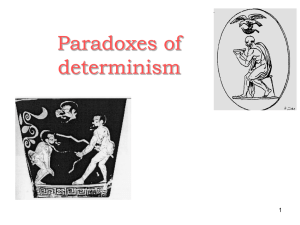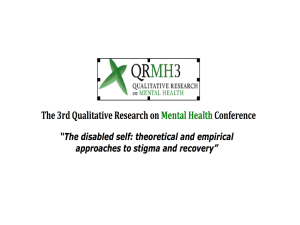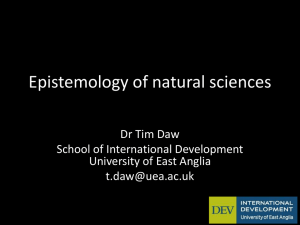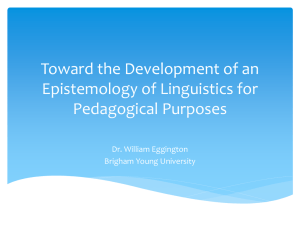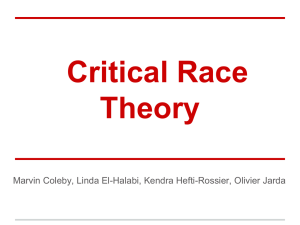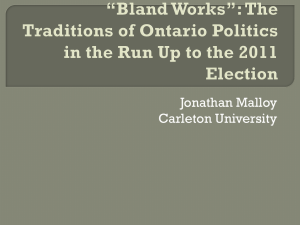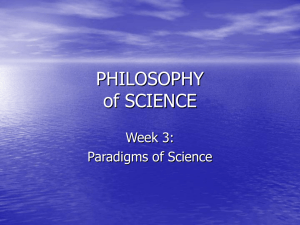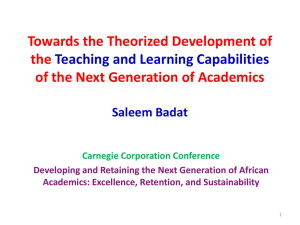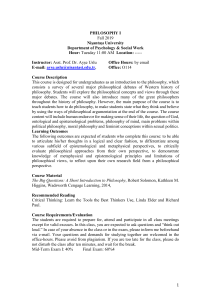IbekweSanJuanSlides
advertisement
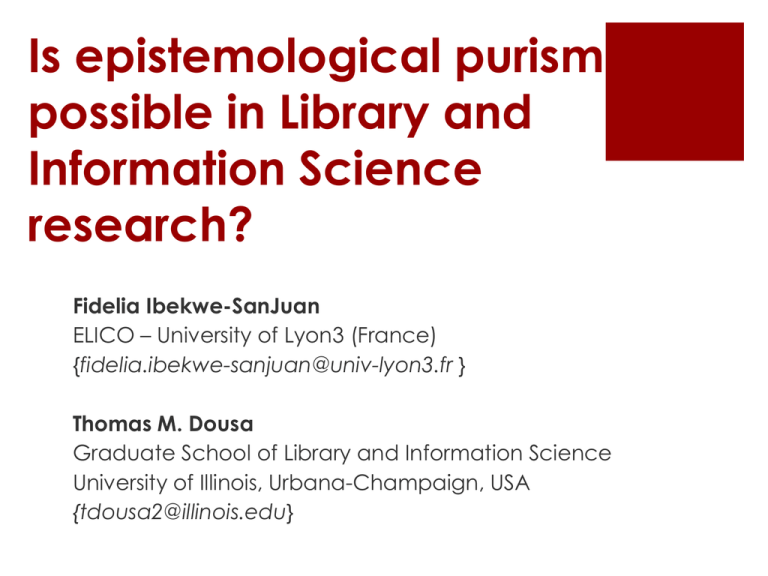
Is epistemological purism
possible in Library and
Information Science
research?
Fidelia Ibekwe-SanJuan
ELICO – University of Lyon3 (France)
{fidelia.ibekwe-sanjuan@univ-lyon3.fr }
Thomas M. Dousa
Graduate School of Library and Information Science
University of Illinois, Urbana-Champaign, USA
{tdousa2@illinois.edu}
Motivation
LIS is mostly driven by practical applications
(Bates 2005, 2007)
Need to ground the field in epistemologicallymotivated methods (Bawden & Robinson 2012;
Brookes 1980; Buckland 2012; Cornelius 2002)
Incorporate epistemology and philosophy into
LIS curricula (Furner 2010; Hjørland 1998, 2010)
What’s at stake?
“Epistemology is at the basis of the question
"what is the scientific method?” (Hjørland 2010)
Different scientific methods are coupled, more
or less closely, with different epistemological
positions.
But there is need to draw a distinction between
epistemological views and methods based on
them (Hjørland 1998, 163).
Some major epistemological
positions according to Hjørland
Empiricism
knowledge acquisition through observations and experimentation, by induction
Rationalism
knowledge gained through reasoning, an innate faculty
Positivism
knowledge gained through analytico-deductive reasoning
Historicism/Hermeneutics
knowledge acquisition through consideration of history, contexts, culture, geography
and subjectivity
Pragmatism
knowledge acquisition on the basis of satisfying goals and purposes of a person or a
community
(Hjørland 2010)
Is epistemological purism
possible?
How can we answer these calls and make explicit
the epistemological assumptions underlying a
given piece of research work which we have
carried out?
Is one piece of research likely to embody one
epistemological assumption from a given
epistemological view, at various stages of its
completion or various?
Boundaries between epistemological theories
can be fuzzy (e.g., in Philosophy, is Kant’s
epistemology empiricist and rationalist ?).
Is epistemological purism
possible?
With respect to KO (Hjørland 2003, 2011):
Facet
analysis
is
seenas
a
“rationalist”
approach/stemming from rationalism
Some automatic indexing techniques are classified
as “empiricist”/ stemming from empiricism
But in reality/practice, a single classification or
indexing method may embody assumptions from
more than one epistemological theory.
Is epistemological purism
possible?
For instance:
S. I. Ranganathan’s Colon Classification appears to
be grounded in a rationalist epistemology, in
practice, he combined rationalism and pragmatism
or “pragmatic-rationalism” in the actual realization
of his classification (Tennis 2008).
Julius Otto Kaiser’s method of Systematic Indexing:
“his epistemological and methodological positions
were hybrid in nature. Kaiser was primarily empiricist
and pragmatist in theory whereas his methodology
was pragmatist in aim but rationalist in mechanics”.
(Dousa 2008).
Is epistemological purism
possible?
Hjørland is commendably aware of this: classification
of epistemological theories into separate categories
are “idealizations” which usually do not exist in pure
forms.
He observed that the four major epistemological views
are interconnected: for “any kind of pragmatism is
limited by constraints set by the real world through
empirical evidence” (Hjørland 2003: 107)
pragmatism is “closely related to historicism by
understanding that observations are contextual”
(Hjørland 2009: 1526), even if pragmatism places more
emphasis on purpose.
Is epistemological purism
possible?
methodological hybridity underlies what would
seem to be epistemologically “monolithic”
approaches or schemes
Is epistemological purism
possible?
So in essence: LIS and KO theorists and
practitioners may espouse one or more
epistemological views as the basis of their
research in theory (their discourse), but depart
from it/them in practice (i.e., when building the
knowledge artifact) …
How can we demonstrate/illustrate this better?
Our Approach
Take 1 – 2 examples from the fields in LIS
(i.e., a case study approach)
Unpack the stages involved and uncover
the epistemological assumptions operative
at each stage as well as the
limitations/biases of these assumptions
Fields for Our Case Study
Information Retrieval (IR)
Topic Mapping
* Chen C., Ibekwe-SanJuan F., SanJuan E., & Vogeley M.S (2008)
* SanJuan & Ibekwe-SanJuan (2006)
* Ibekwe-SanJuan & SanJuan (2010)
Illustration
IR (Information Retrieval)
Topic Mapping
Combination of empiricism + positivism …
with a dash of pragmatism + hermeneutics
Steps 1 & 2: Data collection &
feature selection
From empiricist assumptions…
Frequency is a topic marker
Frequently co-occurring units reflect similarity of content
and hence of documents;
statistical behaviours of textual units capture what a
document or a query is about.
…To empirical models
statistical or probabilistic models are built to approximate
these observations
Induction process: rules or models built from the
observations of a particular set of documents
not universal: may not hold in all cases
Steps 1 & 2: Data collection &
feature selection
Example: Astronomy domain (Chen et al. 2008),
Corpus of 1,293 bibliographic records of SDSS-related
publications retrieved from the ISI-WoS database.
Sloan Digital Sky Survey (SDSS) http://www.sdss.org/
Steps 1 & 2: Data collection &
feature selection
1 G_Mean tf.idf Match_SQL_tf.idf
Freq Docs term
0,55 0,95
0,57
78
43 white dwarf
0,38 0,59
0,65
49
39 dark matter halo
0,36
1
0,36
89
64 luminosity function
0,32 0,72
0,45
57
38 velocity dispersion
0,32 0,81
0,39
74
58 star formation
0,3 0,63
0,47
59
53 active galactic nucleus
0,28 0,77
0,36
62
40 early-type galaxy
0,28 0,59
0,47
50
42 large-scale structure
0,27 0,43
0,63
37
35 cosmic microwave background
0,26 0,52
0,5
39
28 star formation history
0,26 0,61
0,42
45
29 power spectrum
0,26 0,62
0,41
56
49 emission line
0,25 0,74
0,34
59
38 stellar mass
0,25 0,39
0,63
27
18 black hole mass
0,24 0,7
0,34
60
46 spectral type
0,24 0,5
0,48
42
36 dark matter
0,24 0,43
0,55
30
19 black hole
0,23 0,47
0,49
37
30 gravitational lensing
0,21 0,32
0,65
23
18 supermassive black hole
0,21 0,62
0,33
48
33 photometric redshifts
Table 1. Top 20 terms ranked by G(t) function on the SDSS corpus (Chen et al. 2008).
Step 3: Implementation phase
From empiricism to positivism
Deduction of general rules which translate previous
observations into formal models on the basis of
which an algorithm could be written to perform the
task at hand.
The algorithm rendered as a mathematical or
logical statement and then translated into a
computer program via a programming language
Tacit presupposition that there is an ideal way in
which the task at hand can be modeled in a
mathematical language.
Reflects positivist assumptions
Step 4: Representation phase
Sliding into hermeneutics and pragmatism
Interpreting knowledge artifacts
Lists
Graphs
the global form or layout,
the relative positions of nodes with regard to one
another,
their sizes, color, shape, and links to one another.
Requires
pragmatics
(goals,
purposes)
and
hermeneutics (background knowledge; subjectivity;
cultural, historical, and literary context)
Step 4: Representation phase
Figure 2. Map of research topics in KO for the period 1998-2008.
Source: Ibekwe-SanJuan & SanJuan (2010).
Step 4: Representation phase
Sliding into hermeneutics and pragmatism
Case of IR
concept of relevance in IR is slippery (Buckland 2012)
cannot be measured by intrinsically
can only be judged by the user
Relevance judgments are contextual and situational, can
change over time even with regard to the same
documents (Bawden & Robinson, 2012)
Why should we care?
Research design in general
Epistemological theories come with own ontological
commitments, i.e., assumptions about what counts as
an entity for the purposes of a given piece of research
and what can be said about it (Quine 1948, Hjørland
2013).
Epistemological theories determine choice of methods
… and the interpretation of results gained from those
methods.
Why should we care?
KOS design in particular
Hjørland (2013: 1) “the field of knowledge organization itself is
based on different approaches and traditions such as user-based
and cognitive views, facet-analytical views, numeric taxonomic
approaches, bibliometrics and domain-analytic approaches:
these approaches and traditions are again connected to
epistemological views, which have to be considered.”
each epistemological view entails ontological commitments that
determine what concepts are chosen to represent the subject
content of documents and how these concepts are related to
one another
It is important to know which epistemological criteria were used
to construct a knowledge organization system (KOS)
Why should we care?
KOS design in particular
Design decisions about what concepts to include within a KOS,
what linguistic labels to use to refer to them, and what kinds of
relationships to posit between them, are made at a given time
and in light of a given purpose and within the horizon of a given
theory or system.
All KOSs have a pragmatic and a historical dimension that
determine both their form and content.
Why should we care?
KOS design in particular
Yet, traditional admonitions to follow the “usage” of the users in
the choice of terms (Cutter, 1904), select vocabulary from the
literature, as a basis for facet classification (Vickery 1960) or to
seek “literary warrant” in the definition of classes point to
empiricist dimensions as well while the use of categories points
to rationalist ones.
Recognition of the “different epistemological moments” in KOS
design affords better understanding of the process of creating a
KOS.
Why should we care?
Implications for academics & info professionals
Clarify aspects of phenomena that are favored or brought to the
forefront and which are kept out of account or relegated to the
background in the course of R & D.
simulation/modelling/design are reduction processes, i.e.,
simplifications of otherwise complex and multifaceted realities.
Hence, practitioners should be aware of the various factors that
have contributed to the particular Gestalten of the KOSs that
they design or apply.
Why should we care?
Enable stakeholders, policy makers, users, and, on a broader level,
members of the general public to evaluate the results of a given
piece of research with due knowledge of the presuppositions that
shaped its design
Loss in users’ confidence and trust if biases and limitations of
research and practical results are not made explicit
One may well wonder whether, ultimately, pragmatics
and hermeneutics are not the overall driving forces,
conforming knowledge artifacts, to paraphrase Kant,
to our thought.
Thank you!
Questions?
References
Bates M.J. (2005). Information and knowledge: an
evolutionary framework for information science,
Information Science Research, n° 10(4), Online at
http://InformationR.net/ir/10-4/paper239.html.
Bates M.J. (2007). Defining the information disciplines in
Encyclopedia development, Information Science
Research, 12(4). Online at http://informationr.net/ir/124/colis/colis29.html
Bawden D., & Robinson L. (2012). Introduction to
Information Science, Facet Publishing, London.
Brookes B.C., (1980). The foundations of information
science: part I. Philosophical aspects, Journal of
Information Science, n° 2 (3): 125-133.
References
Buckland M. (2012). What kind of science can
Information Science be? Journal of the American
Society of Information Science & Technology, n° 63(1): 17.
Chen C., Ibekwe-SanJuan F., SanJuan E., & Vogeley M.S.
(2008). Identifying Thematic Variations in SDSS Research,
Proceedings of the 9th International Conference on
Textual Data Statistical Analysis (JADT-08), Lyon, France,
12-14 March 2008, 319-330.
Cornelius I. (2002). Theorizing Information for Information
Science, Annual Review of Information Science and
Technology, n° 36: 393-425.
References
Dousa T. M. (2008). Empirical observation, rational structures, and pragmatist
aims: epistemology and method in Julius Otto Kaiser’s theory of systematic
indexing. In C. Arsenault & J. T. Tennis (eds.), Culture and Identity in
Knowledge Organization: Proceedings of the Tenth International ISKO
Conference, 5–8 August 2008, Montréal, Canada. Advances in Knowledge
Organization, vol. 11. Würzburg: Ergon Verlag,, 242–248.
Furner J. (2010). Philosophy and Information Studies, Annual Review of
Information Science & Technology, n° 44: 159-200.
Hjørland B. (1998). Theory and metatheory of information science: a new
interpretation, Journal of Documentation, n° 54 (5) : 606-621.
References
Hjørland B. (2003). Fundamentals of knowledge organization. Knowledge
Organization, 30(2): 87-111.
Hjørland B. Concept theory. Journal of the American Society for Information
Science and Technology, 60(8), 2009: 1519-1536.
Hjørland B., Epistemological paradigms in knowledge organization, 11th
International Conference of the International Society for Knowledge
Organization (ISKO), Rome, 23-26 February, 2010. [unpublished seminar
paper].
Hjørland B. (2013). Theories of Knowledge Organization — Theories of
Knowledge, 13th Meeting of the German chapter of ISKO (International
Society for Knowledge Organization), Potsdam, 19th March 2013, 20 pages.
[Keynote
paper].
Online
at
http://www.iskode.org/data/uploads/KOAndTheoriesOfKnowlede.pdf
References
Ibekwe-SanJuan F., & SanJuan E., Knowledge Organization Research in
the last two decades: 1988‐2008. (2010). In C. Gnoli & F. Mazzocchi (eds.),
Paradigms and conceptual systems in KO: Proceedings of the 11th
International Conference of the International Society for Knowledge
Organization (ISKO), 23-26 February 2010, Rome, Italy. Advances in
Knowledge Organization, Vol. 12. Würzburg: Ergon Verlag, 115-121.
Quine, W. V. O. (1948). On what there is. Review of Metaphysics, 2(5): 21–
28.
SanJuan E., & Ibekwe‐SanJuan F. (2006). Textmining without document
context, Information Processing & Management 42(6), 2006: 1532-1552.
References
SanJuan E., Flavier N., Ibekwe-SanJuan F., Bellot P. (2008). Universities of
Avignon & Lyon3 at TREC 2008 Enterprise Track, 17th TREC Conference
Proceedings, NIST Special Publication SP 500-277, Gaithersburg, Maryland,
18‐21
Nov.
2008,
6p.
Online
at
http://trec.nist.gov/pubs/trec17/t17_proceedings.html
Tennis J. T. (2008). Epistemology, theory, and methodology in knowledge
organization, Knowledge Organization, n° 35 2/3: 102-112.
